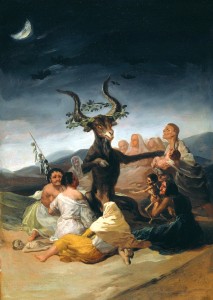When I started my research I did not know exactly what I would find at the end. I only had a vague idea of my topic and still had to do plenty of reading before I had a firm grasp on the subject of witchcraft.
Firstly, I realized that most people tried for witchcraft in the twelfth century committed very surprising and not at all supernatural crimes. They were surprising because these crimes were very petty like finding lost money or fortune  telling. Even more, the terms which were used to describe magic were umbrella terms, all meaning some kind of supernatural act, but not necessarily an evil act. In the light of these revelations I had a hard time believing that at the same time period “simple people” believed in witchcraft and the terrible tales of the witches’ Sabbath.
telling. Even more, the terms which were used to describe magic were umbrella terms, all meaning some kind of supernatural act, but not necessarily an evil act. In the light of these revelations I had a hard time believing that at the same time period “simple people” believed in witchcraft and the terrible tales of the witches’ Sabbath.
Later, the typical process of the witch trial evolved from the earlier legal roots and it very heavily relied on the folkloric image of witches, but there was no ground for accusation in the Bible, which is quiet on the subject of witches. The women accused of witchcraft became the evil agents of the devil and most of the time they cursed their neighbours with evil intent, which became the most recognizable sign of a witch. But in the background of these legal events there was a consistent image of witchcraft among ordinary people. Though there were plenty of signs of witchcraft, and all women had a lot in common, the most defining quality remained the evil intent. This is underlined by the most popular forms of magic in the sixteenth century, which were maleficium and veneficium, both marking an evil act, the latter not even necessarily magical. I expected literary figures to be more like the typical witch from folk tales and not the witches known from legal practices.
Francisco Goya: Witches’ Sabbath, 1797-98.
But when I examined Morgan le Fay more closely I had to realize that her figure was more consistent with witches of the legal practice. She was a gifted healer in her first appearance and slowly became the primary antagonist of the Arthurian cycle. While she was a consistently supernatural being, her character started out as a positive one, healing Arthur from his wounds and slowly evolves into the evil antagonist.
Source of image: https://en.wikipedia.org/wiki/Witches%27_Sabbath_(Goya,_1798)


thank you for sharing